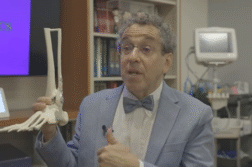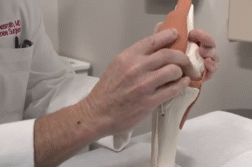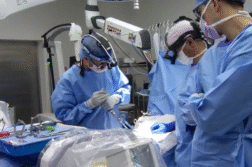CHICAGO, Ill. (Ivanhoe Newswire) – About 800,000 people will get a knee replaced this year. More than half a million will get a new hip, and 50,000 will get their shoulder replaced. Wrist replacements are less common, but now, new technology and improved techniques are helping surgeons help people with painful, arthritic wrists.
Wrists — they can move any which way. They’re made up of 10 small bones, and three joints.
“The wrist joint is composed of the radiocarpal joint, which is the wrist that goes back and forth, but people don’t realize that the other half of the joint is this joint,” explains Hand, Wrist & Elbow Specialist at Midwest Orthopaedics at RUSH, John Fernandez, MD.
And when one of those bones or joints goes bad, people can be left in pain, and until recently, doctors could do little to help.
Dr. Fernandez further explains, “The way we would treat this is, we would remove that bone and, literally, throw it away. And then, we would pray that the connection between these two bones would be restored, but it really would never be truly restored.”
But now, Dr. Fernandez is one of the few surgeons in the country to replace the distal radial ulnar joint with a metal implant.
“It’s like putting the hinge back on the door. So, now, the door can open properly. And what’s most remarkable is, you see these patients two weeks later, they have no pain. And these are patients who have been in pain for literally 20 years. They’ve had five or six failed surgeries,” Dr. Fernandez adds.
And the best part? No rehab!
“There’s none because you haven’t touched the muscles, you haven’t touched the tendons,” Dr. Fernandez mentions.
Within two weeks, patients are back doing what they love – active, without pain.
The only restriction is no heavy lifting. So, if you are younger or have a strenuous job, wrist replacements may not be a good option. Now, doctors are working on how best to replace the other main joint in the wrist which is the radial carpal joint.
Contributors to this news report include: Marsha Lewis, Producer; Midwest Orthopaedics at RUSH, Videographer; Roque Correa, Editor.
To receive a free weekly e-mail on medical breakthroughs from Ivanhoe, sign up at: http://www.ivanhoe.com/ftk
Source:
MEDICAL BREAKTHROUGHS
RESEARCH SUMMARY
TITLE: THE NEW “NO REHAB” WRIST REPLACEMENT
REPORT: MB #5387
BACKGROUND: The wrist joint is a complex structure comprising the distal ends of the radius and ulna (forearm bones), eight small carpal bones, and the proximal portions of the metacarpal bones of the hand. These bones are interconnected by ligaments and tendons, which facilitate a range of motion including flexion, extension, and side-to-side movements. Wrist replacement, also known as wrist arthroplasty, is a surgical procedure designed to replace the damaged or diseased wrist joint with an artificial implant. This procedure is typically considered for patients with severe arthritis or other degenerative joint diseases that significantly impact wrist function and cause chronic pain. Wrist replacements are performed less frequently compared to hip, knee and shoulder replacements.
(Sources: https://orthoinfo.aaos.org/en/treatment/wrist-joint-replacement-wrist-arthroplasty/
https://my.clevelandclinic.org/health/treatments/22097-wrist-replacement-wrist-arthroplasty)
DIAGNOSING: Wrist replacement surgery is usually recommended for: rheumatoid arthritis, osteoarthritis, post-traumatic arthritis, avascular necrosis or failed wrist surgeries. Common symptoms of these types of arthritis include, but are not limited to: pain, stiffness, swelling, redness and/or decreased range of motion. Some common risk factors that can contribute to arthritis are family history, age, sex, previous joint injury and/or obesity. Doctors can diagnose arthritis with lab tests and a series of imaging tests, including: x-rays, CT scans, MRIs and ultrasounds.
(Sources: https://my.clevelandclinic.org/health/treatments/22097-wrist-replacement-wrist-arthroplasty
https://www.mayoclinic.org/diseases-conditions/arthritis/symptoms-causes/syc-20350772
https://www.mayoclinic.org/diseases-conditions/arthritis/diagnosis-treatment/drc-20350777)
NEW TECHNOLOGY: Midwest Orthopaedics at RUSH has developed a new way to perform wrist replacements that don’t require rehabilitation. John Fernandez, MD, Hand, Wrist & Elbow Specialist at Midwest Orthopaedics at RUSH is one of few surgeons in the United States replacing the distal radial ulnar joint. “First, he removes the end of the bone, replacing it with a metal implant. A long metal stem is inserted in the forearm bone. A metal ball is attached. When the wrist rotates, it’s rotating around the end of that ball.”
(Source: John Fernandez, MD, Hand, Wrist & Elbow Specialist, Midwest Orthopaedics at RUSH)
FOR MORE INFORMATION ON THIS REPORT, PLEASE CONTACT:
Ann Pitcher
If this story or any other Ivanhoe story has impacted your life or prompted you or someone you know to seek or change treatments, please let us know by contacting Marjorie Bekaert Thomas at mthomas@ivanhoe.com




